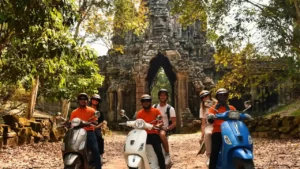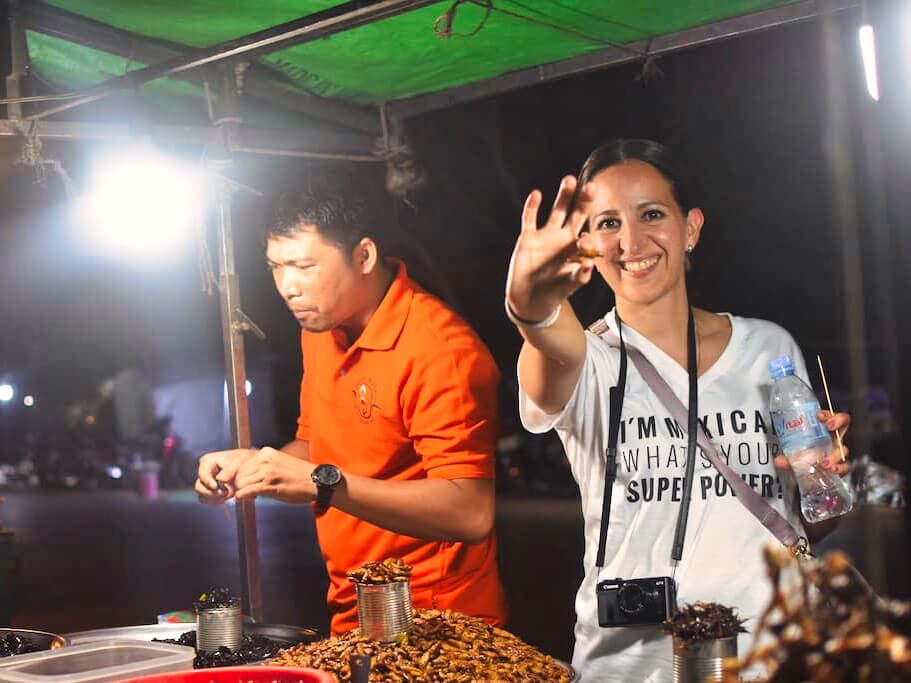Few people know the exact details of André Malraux‘s controversial adventure in Cambodia in 1923. Long before becoming a central figure in French culture, this young writer found himself at the heart of an archaeological scandal after attempting to steal precious Khmer sculptures from the remote temple of Banteay Srei. Thanks to historical archives, we now have a clearer view of what really happened. Join us as we unravel this fascinating tale of theft, ruins, and eventual redemption.
An Isolated Temple, The Target of a Bold Expedition
At the time, Banteay Srei was not the tourist destination it is today. Located about 20 km northeast of Angkor, it was largely collapsed and hidden beneath Cambodia’s dense jungle. This impressive pre-Angkorian ruin, built in the 10th century under King Rajendravarman II, is a masterpiece of Khmer architecture. The name Banteay Srei, which translates to “Citadel of Women,” likely refers to the delicate female sculptures that adorn its walls. However, in 1923, the temple was little more than a pile of stones to Malraux and his companions. For more information on the history of Angkor’s temples, you can visit the UNESCO website.
The Construction and Importance of Banteay Srei Temple
Built in 967 AD, the Banteay Srei temple is dedicated to the Hindu god Shiva. It is renowned for the exceptional quality of its carvings in pink sandstone, a material unique to this region. The detailed bas-reliefs on its walls depict gods, temple guardians (devatas), and mythological scenes from the Ramayana epic. While today, Banteay Srei stands as a testament to Khmer art’s refinement, at the time of Malraux’s visit, the temple had yet to undergo the restoration efforts led by the École Française d’Extrême-Orient (EFEO).
The Intrigue: Malraux’s Plan
To Malraux, the discovery of this hidden temple was an ideal opportunity. Facing financial ruin after failed stock market investments, he decided to launch an expedition to steal sculptures and sell them to European antique dealers. Accompanied by his wife Clara and his friend Louis Chevasson, he traveled to Banteay Srei in December 1923 with a very clear plan.
The team spent two days in the temple, armed with rudimentary tools. Their goal: to saw and extract several finely carved bas-reliefs depicting devatas, the famous female divinities that adorn the temple’s facades. While the operation went smoothly in the jungle, things quickly escalated when they returned to Phnom Penh.
You are traveling to Cambodia read: Currency in Cambodia What You Need to Know
The Arrest: A Cinematic Scenario
Malraux, Clara, and Chevasson managed to extract the sculptures, but the situation worsened upon their arrival in Phnom Penh. Thanks to tips from local guides and increased surveillance by colonial police, authorities quickly suspected a theft. Chevasson’s luggage was searched, and the stolen bas-reliefs were discovered. Malraux, caught red-handed, denied his involvement and blamed his accomplice. However, the evidence was clear: the artifacts were confiscated, and the two men were placed under house arrest, awaiting trial.
Read more details on this case in this article from Le Monde.
The Reaction in Paris: Scandal and Defense
News of the affair quickly spread through Paris’s intellectual circles. André Breton, the leader of the surrealist movement and a close friend of Malraux, publicly defended him. Breton argued that Malraux had no ill intentions and believed he was actually saving these sculptures by removing them from Cambodia, where he claimed they were being neglected. “Who really cares about the preservation of these works in their country of origin?” Breton asked in the French press.
Despite such support, the verdict was handed down in 1924: Malraux was sentenced to three years in prison for theft. However, this sentence was reduced on appeal to one year with a suspended sentence, likely due to pressure from the Parisian intelligentsia. Ironically, this episode helped to forge Malraux’s image as an adventurer, a man willing to challenge laws in the name of art.
A Complex Legacy
Malraux would later downplay this episode in his memoirs, preferring to focus on his political and literary contributions. Yet, the Banteay Srei affair left a lasting mark on the history of Cambodia’s cultural heritage. While the stolen bas-reliefs were eventually returned thanks to the EFEO’s efforts, the incident still raises questions today about the protection of artistic treasures in colonized countries.
Thanks to restoration efforts led by archaeologist Henri Marchal in the 1930s, the Banteay Srei temple was restored, and the bas-reliefs were returned to their original positions. To see these incredible sculptures for yourself, a visit to Angkor and Banteay Srei is a must.
Learn more about the Banteay Srei & Siem Reap Countryside by Jeep here..
The Banteay Srei Temple: Beauty and Mystery
Today, Banteay Srei is one of Angkor’s most stunning gems. Its pink sandstone, unique to the region, shines at sunrise and sunset, giving the temple an almost mystical glow. Visitors are captivated by the intricate detail of the carvings, especially the devatas, who seem to come to life on the elaborately decorated walls. Yet behind this beauty lies a complex history, one of a brazen theft that nearly deprived Cambodia of some of its most precious artwork.
Majestic Construction
Banteay Srei’s architecture is a testament to the artistic genius of the Khmer Empire. Its design features harmonious proportions and a meticulous attention to detail. The temple consists of three successive enclosures, at the center of which are three brick and sandstone towers, intricately decorated. The motifs of lotus leaves, mythical nagas (serpents), and Hindu gods like Shiva and Vishnu are omnipresent, symbolizing both religious devotion and the artistic brilliance of the Khmer civilization.
Why is Banteay Srei Unique?
- Small scale but refined details: Unlike vast temples like Angkor Wat, Banteay Srei stands out for its smaller size. However, each stone is carved with exceptional care, making it a miniature masterpiece of art.
- Use of pink sandstone: This softer, rarer material allows for the temple’s finely detailed carvings. The pink sandstone captures light differently, giving the temple a golden glow at certain times of day.
- A temple dedicated to Shiva: Though small in scale, the temple is dedicated to the Hindu god Shiva, as evidenced by the numerous depictions of the god performing his cosmic dance on the eastern lintel of the gopura (gate). Shiva, the master of the cosmic dance, symbolizes both destruction and creation, a recurring theme in Cambodia’s Hindu iconography.
Conclusion: A Lesson in History and Preserved Heritage
The Banteay Srei theft by André Malraux continues to spark debates, but it also highlights the importance of preserving cultural heritage in colonized nations. Fortunately, the stolen bas-reliefs were returned, and thanks to restoration efforts, Banteay Srei has become one of Angkor’s most prized archaeological sites.
FAQs
1. Why did André Malraux attempt to steal sculptures from Banteay Srei? Malraux hoped to sell the sculptures to European antique dealers to recover from financial losses after failed stock market investments.
2. What were the consequences of his theft? Malraux was arrested and sentenced to three years in prison, reduced to one year with a suspended sentence on appeal. The stolen sculptures were returned to Cambodia.
3. How was Banteay Srei restored? Restoration efforts led by Henri Marchal and the EFEO in the 1930s helped return the temple to its former glory, including the return of the stolen bas-reliefs to their original positions.
4. What makes Banteay Srei unique among Angkor’s temples? Its use of pink sandstone, smaller size, and intricate details make Banteay Srei a standout example of Khmer art and architecture.










